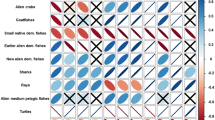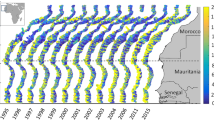Abstract
The marine ecosystem response to climate change and demersal trawling was investigated using the coupled hydrodynamic-biogeochemical water column model GOTM-ERSEM-BFM for three contrasting sites in the North Sea. Climate change forcing was derived from the HadRM3-PPE-UK regional climate model for the UK for the period 1950–2100 using historical emissions and a medium emissions scenario (SRESA1B). Effects of demersal trawling were implemented as an additional mortality on benthic fauna, and changes in the benthic–pelagic nutrient and carbon fluxes. The main impacts of climate change were (i) a temperature-driven increase in pelagic metabolic rates and nutrient cycling, (ii) an increase in primary production fuelled by recycled nutrients, (iii) a decrease in benthic biomass due to increased benthic metabolic rates and decreased food supply as a result of the increased pelagic cycling, and (iv) a decrease in near-bed oxygen concentrations. The main impacts of trawling were (i) reduced benthic biomass due to the increased mortality, and (ii) the increased benthic–pelagic nutrient fluxes, with these effects counteracting each other, and relatively small changes in other variables. One important consequence was a large decrease in the de-nitrification flux predicted at the two summer-stratified sites because less benthic nitrate was available. The effects of trawling scaled linearly with fishing effort, with greatest sensitivity to fishing in summer compared to fishing in winter. The impacts of climate change and trawling were additive, suggesting little or no non-linear interactions between these disturbances.











Similar content being viewed by others
References
Allen J, Clarke K (2007) Effects of demersal trawling on ecosystem functioning in the North Sea: a modelling study. Mar Ecol Prog Ser 336:63–75
Baretta JW, Ebenhöh W, Ruardij P (1995) The European Regional Seas Ecosystem Model, a complex marine ecosystem model. J Sea Res 33:233–246
Birchenough SNR, Parker ER, Bolam SG (2012) SPI-ing on the seafloor: assessing benthic systems with traditional and in situ observations. Biogeochem, this issue (in revision)
Brey T. (2001) Population dynamics in marine benthic invertebrates. A virtual handbook, Version 01.2, 2001. Alfred Wegener Institute for Polar and Marine Research, Germany. http://www.thomas-brey.de/science/virtualhandbook/navlog/index.html
Burchard H, Bolding K, Villareal MR (1999) GOTM—a general ocean turbulence model. Theory, applications and test cases. Tech. Rep. EUR 18745 EN, European Commission
Capuzzo E, Painting SJ, Forster RM, Greenwood N, Stephens DT, Mikkelsen OA (2012) Variability in the sub-surface light climate at ecohydrodynamically distinct sites in the North Sea. Biogeochemistry, this issue (in revision)
Collins M (2007) Ensembles and probabilities: a new era in the prediction of climate change. Philos Trans R Soc A 365:1957–1970. doi:10.1098/rsta.2007.2068
Couceiro F, Fones GR, Thompson CEL, Statham PJ, Sivyer DB, Parker R, Kelly-Gerreyn BA, Amos CL (2012) Impact of resuspension of cohesive sediments at the Oyster Grounds (North Sea) on nutrient exchange across the sediment–water interface. Biogeochemistry. doi:10.1007/s10533-012-9710-7
Doney S (2010) The growing human footprint on coastal and open-ocean biogeochemistry. Science 328:1512–1516
Engel A (2000) The role of transparent exopolymer particles (TEP) in the increase in apparent particle stickiness (α) during the decline of a diatom bloom. J Plankton Res 22(3):485–497
Forryan A, Kelly-Gerreyn BA, Aldridge J, Parker R (2012) The role of megafauna in benthic recovery from trawling: a modelling study. Mar Ecol Prog Ser (in revision)
Greenwood N, Parker ER, Fernand L, Sivyer DB, Weston K, Painting SJ, Kröger S, Forster RM, Lees HE, Mills DK, Laane RWPM (2010) Detection of low bottom water oxygen concentrations in the North Sea; implications for monitoring and assessment of ecosystem health. Biogeosci 7:1357–1373
Hawkins E (2010) Our evolving climate: communicating the effects of climate variability. Weather 66:175–179
IPCC (2007) Climate Change 2007: synthesis report. IPCC Plenary XXVII, Valencia, Spain, 12–17 November 2007. http://www.ipcc.ch/publications_and_data/publications_ipcc_fourth_assessment_report_synthesis_report.htm
Johnson MT, Greenwood N, Sivyer DB, Thomson M, Reeve A, Jickells TD (2012) Characterising the seasonal cycle of dissolved organic nitrogen in the Southern North Sea using Cefas SmartBuoy high-resolution time-series samples. Biogeochemistry. doi:10.1007/s10533-012-9738-8
Kaiser MJ, De Groot SJ (eds) (2006) The effects of fishing on non-target species and habitats: biological conservation and socioeconomic issues. Blackwell, Oxford
Kürten B, Painting SJ, Struck U, Polunin NVC, Middelburg JJ (2011) Tracking seasonal changes in North Sea zooplankton trophic dynamics using stable isotope. Biogeochemistry. doi:10.1007/s10533-011-9630-y
Kürten B, Frutos I, Struck U, Painting SJ, Polunin NVC, Middelburg JJ (2012). Trophodynamics and functional feeding groups of North Sea fauna: a combined stable isotope and fatty acid approach. Biogeochemistry. doi:10.1007/s10533-012-9701-8
Lee J, South AB, Jennings S (2010) Developing reliable, repeatable, and accessible methods to provide high-resolution estimates of fishing-effort distributions from vessel monitoring system (VMS) data. ICES J Mar Sci 67:1260–1271
Lenhart HJ, Mills DK, Baretta-Bekker H, van Leeuwen SM, van der Molen J, Baretta JW, Blaas M, Desmit X, Kühn W, Lacroix G, Los HJ, Ménesguen A, Neves R, Proctor R, Ruardij P, Skogen MD, Vanhoutte-Grunier A, Villars MT, Wakelin SL (2010) Predicting the consequences of nutrient reduction on the eutrophication status of the North Sea. J Mar Syst 81:148–170
Meier H, Kjellstrom E, Graham L, 2006. Estimating uncertainties of projected Baltic sea salinity in the late 21st century. Geophysical Research Letters 33(15), {L}15705, doi: 10.1029/2006GL026488
Met Office, Hadley Centre. HadRM3-PPE-UK Model Data, [Internet]. NCAS British Atmospheric Data Centre, 2008-, Januari 2012. Available from http://badc.nerc.ac.uk/view/badc.nerc.ac.uk__ATOM__dataent_12178667495226008
Murphy JM, Booth BBB, Collins M, Harris GR, Sexton DMH, Webb MJ (2007) A methodology for probabilistic predictions of regional climate change from perturbed physics ensembles. Phil. Trans. R. Soc. A 365:1993–2028. doi:10.1098/rsta.2007.2077
Neubacher EC (2009) Oxygen and nitrogen cycling in sediments of the southern North Sea. Queen Mary, University of London, Ph.D.-thesis
Painting SJ, Oosterhuis SS, Capuzzo E, Baars MA, Forster RM, Milligan SP, Fernand LJ, Sivyer DB (2012) Structure and function of the pelagic food web at 3 sites in the North Sea during 2007. Biogeochemistry, submitted
Peperzak L, Colijn F, Gieskes WWC, Peeters JCH (1998) Development of the diatom-Phaeocystis spring bloom in the Dutch coastal zone of the North Sea: the silicon depletion versus the daily irradiance threshold hypothesis. J Plankton Res 20(3):517–537
Petihakis G, Smith CJ, Triantafyllou G, Sourlantzis G, Papadopoulou K-N, Pollani A, Korres G (2007) Scenario testing of fisheries management strategies using a high resolution ERSEM-BFM-POM ecosystem model. ICES J Mar Sci 64:1627–1640
Pope V, Brown S, Clark R, Collins M, Collins W, Dearden C, Gunson J, Harris G, Jones C, Keen A, Lowe J, Ringer M, Senior C, Sitch S, Webb M, Woodward S (2007) The Met Office Hadley Centre climate modelling capability: the competing requirements for improved resolution, complexity and dealing with uncertainty. Philos Trans R Soc A 365:2635–2657. doi:10.1098/rsta.2007.2087
Radach G, Moll A (2006) Review of three-dimensional ecological modelling related to the North Sea shelf system. Part II: model validation and data needs. Oceanogr Mar Biol 44:1–60
Ruardij P, van Raaphorst W (1995) Benthic nutrient regeneration in the ERSEM-BFM ecosystem model of the North Sea. Neth J Sea Res 33:453–483
Ruardij P, van Haren H, Ridderinkhof H (1997) The impact of thermal stratification on phytoplankton and nutrient dynamics in shelf seas: a model study. J Sea Res 38:311–331
Ruardij P, Veldhuis MJW, Brussaard CPD (2005) Modeling the bloom dynamics of the polymorphic phytoplankter Phaeocystis globosa: impact of grazers and viruses. Harmful Algae 4:941–963
Skogen MD, Moll A (2005) Importance of ocean circulation in ecological modelling: an example from the North Sea. J Mar Syst 57:289–300
Teal LR (2009) The influence of infaunal bioturbation on ecosystem processes in the sediment mixed layer. PhD dissertation, University of Aberdeen
Van Santbrink JW, Bergman MJN (1994) Direct effects of beam trawling on macrofauna in a soft bottom area in the southern North Sea. In: de Groot SJ, Lindeboom HJ (eds) Environmental impact of bottom gears on benthic fauna in relation to natural resources management and protection of the North Sea, pp 147–178. NIOZ Rapport 1994, 11RivoeDLO report C026/94
Verspecht F, Rippeth TP, Howarth MJ, Souza AJ, Simpson JH, Burchard H (2009) Processes impacting on stratification in a region of freshwater influence: application to Liverpool Bay. J Geophys Res 114:C11022. doi:10.1029/2009JC005475
Vichi M, May W, Navarra A (2003) Response of a complex ecosystem model of the northern Adriatic Sea to a regional climate change scenario. Clim Res 24:141–158
Vichi M, Ruardij P, Baretta JW (2004) Link or sink: a modelling interpretation of the open Baltic biogeochemistry. Biogeoscience 1:79–100
Vichi M, Pinardi N, Masina S (2007) A generalized model of pelagic biogeochemistry for the global ocean ecosystem. Part I: theory. J Mar Syst 64:89–109
Acknowledgments
The research was funded by the Department for Environment, Food and Rural affairs (Defra) through contract E3205. The authors thank the Hadley Centre for making the HadRM3-PPE-UK climate change scenario available, and the BADC for their mediation.
Author information
Authors and Affiliations
Corresponding author
Rights and permissions
About this article
Cite this article
van der Molen, J., Aldridge, J.N., Coughlan, C. et al. Modelling marine ecosystem response to climate change and trawling in the North Sea. Biogeochemistry 113, 213–236 (2013). https://doi.org/10.1007/s10533-012-9763-7
Received:
Accepted:
Published:
Issue Date:
DOI: https://doi.org/10.1007/s10533-012-9763-7




